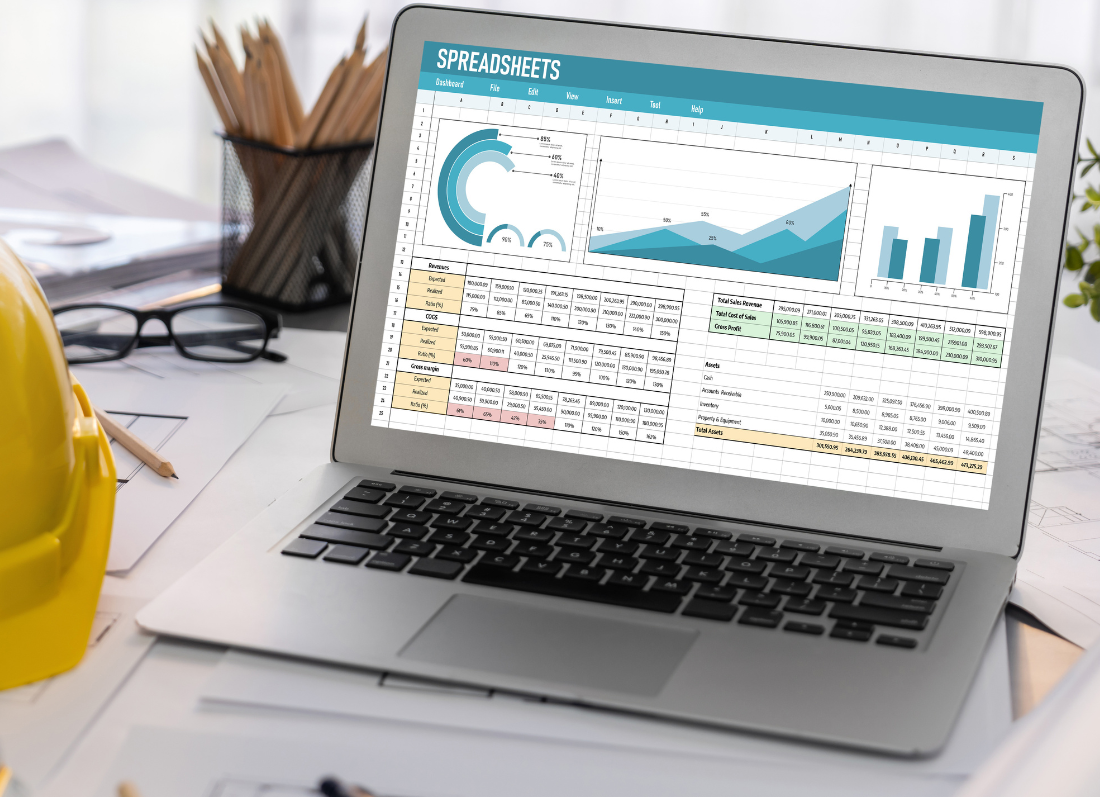Overview of Construction Job Costing Methods
Originally published on July 30, 2025
What if two construction jobs of the same size and scope delivered drastically different profit margins? For many construction companies, this happens more often than it should. The reason usually lies in how job costs are tracked and managed. Job costing is not just a bookkeeping task. It’s a powerful tool for your estimators, project managers and leadership team to make informed decisions, manage risk and improve profitability.
Many construction firms operate under the assumption that their financial systems are solid. But then a sudden cost spike or labor overrun exposes hidden issues. Without a clear view into project-specific costs, even jobs that look profitable can turn into financial losses.
Job costing provides the operational visibility needed to identify where margins are earned or lost, helping companies make smarter, more informed decisions. The method you use matters, and selecting the right approach can have a significant impact on profitability, forecasting and project control.
Why Job Costing Matters: Risks, Returns and Real Numbers
In construction, no two projects are exactly alike. Each one comes with its own site conditions, client demands, labor constraints and change orders. That is what makes job costing so essential. It’s the practice of tracking all costs and revenues for each individual job so you can clearly see whether it is profitable.
Average net profit margins in the construction sector sit between 2-3% for general contractors and 3-6% for specialty contractors. That slim window for profit makes accurate cost tracking a necessity. One overlooked vendor invoice or unrecorded equipment rental can easily eliminate any financial gain from a project. Companies that fail to track costs properly often struggle with cash flow, underbill clients or miscalculate future bids.
Job costing provides transparency into labor, materials, subcontractor fees and overhead tied to each contract. It equips project managers with the information they need to make better purchasing and staffing decisions in real time. For your finance and estimating teams, it builds a historical record that improves accuracy for future proposals and helps protect margins.
When implemented properly, job costing becomes a decision-making engine for your entire construction operation. And that creates a roadmap for profitable growth in a competitive industry.
Key Job Costing Components Every Construction Company Should Track
Job costing begins with knowing what to track. While no two firms cost projects the same way, most construction companies need to monitor six core categories: labor, materials, equipment, subcontractors, overhead and change orders.
Labor is often the largest and most variable cost on any job. Accurate time tracking by phase or activity is essential, especially when using union labor, prevailing wage rates or multiple shifts. Labor overruns can erode profits quickly, so it’s critical to track hours worked and the cost rate per hour (including burdens like payroll taxes and workers’ compensation).
Materials must be tracked down to the delivery, especially on projects where timelines are tight or substitutions are common. A missed materials charge can distort your job’s profitability, and poor material planning can lead to costly delays. Construction accounting systems with purchase order integration can help ensure every material cost is allocated to the right job.
Equipment costs should reflect both owned and rented assets. Owned equipment carries maintenance, fuel and depreciation expenses, while rentals may fluctuate based on market demand. Allocating equipment costs correctly helps ensure bids are accurate and future equipment purchases are based on real job usage.
Subcontractor costs should be tracked separately from labor. While these may be easier to control contractually, it is still important to monitor actual versus budgeted costs, especially when scope changes occur. Detailed tracking also helps in evaluating subcontractor performance over time.
Overhead allocation is often overlooked. Indirect costs such as office salaries, insurance and software subscriptions need to be assigned to jobs proportionally. This gives a more accurate picture of true job costs and helps ensure company-wide financial health. And is required by GAAP if you need CPA prepared FS
Change orders can make or break a job’s profitability. Tracking approved and pending changes in real time is key to maintaining both operational control and client transparency.
Capturing these categories in a structured way provides the detail needed for meaningful job reporting and forecasting.
Comparing Job Costing Methods: Which Approach Fits Your Operation
Construction firms generally use one (or a combination of up to) three primary job costing methods: actual costing, standard costing or activity-based costing. Each has its strengths, and the best choice depends on your company size, job complexity and management style.
Actual costing involves recording the true cost of labor, materials and overhead as it happens. This method provides the most accurate reflection of a project’s financial performance but requires disciplined data collection and detailed job tracking. It works best for firms with strong systems in place and dedicated staff to manage the process.
Standard costing uses predetermined cost estimates for labor and equipment based on historical averages. These standard costs are then compared to actual expenses to identify variances. While this method can streamline project planning and budgeting, it requires ongoing adjustments to remain accurate. It is especially useful for companies with repetitive job types or production-based workflows.
Activity-based costing assigns overhead and indirect costs based on specific activities involved in a project. This method provides deeper insight into what drives costs and can improve pricing strategies. However, it is more complex to implement and manage, making it a better fit for larger firms with the resources to support it.
The Internal Revenue Service requires contractors to use an accounting method that “clearly reflects income” and specifically governs long-term construction contracts under Internal Revenue Code Section 460. Under these rules, firms typically must use the percentage‑of‑completion method (PCM) unless they qualify for small‑contractor or home‑contract exemptions, which allow use of the completed‑contract method (CCM). PCM recognizes revenue and expenses as work progresses, while CCM defers recognition until completion.
Choosing a job costing method is not just an internal preference; each approach has implications for tax compliance, cash‑flow timing and project profitability forecasting. The method you select helps ensure you meet IRS requirements and maintain clear financial insight into each job’s real performance.
Choosing the Right Cost Code Structure: Building Your Job Costing Foundation
A job costing system is only as good as its foundation. For construction firms, that foundation is a well-structured cost code system. Cost codes are the building blocks that organize your job cost data, breaking it into consistent, trackable pieces. Without this structure, even the most detailed data loses its value.
A good cost code setup reflects how your company actually builds. It should be detailed enough to give useful insights but not so granular that tracking becomes burdensome. Most companies organize their codes by major categories such as site work, concrete, framing and finish work, with further breakdowns by task, labor type or location as needed. This allows field teams and accounting staff to speak the same language when tracking job progress and recording costs.
Cost codes also play a key role in generating work in progress (WIP) reports and budget-versus-actual comparisons. These tools help you spot cost overruns before they grow and identify trends in estimating accuracy. For example, if framing labor routinely exceeds budget across multiple jobs, it may signal the need to update labor rate assumptions or improve crew productivity.
Consistency is crucial. Using the same cost code system across all jobs allows for more reliable reporting and better historical analysis. Companies that tailor codes too specifically to each project often struggle to draw meaningful comparisons. It is important to review your cost code structure regularly and update it as your business evolves.
The Role of Technology in Job Costing Accuracy
Technology has become a powerful tool for improving job costing accuracy. Cloud-based accounting platforms and construction management software make it easier than ever to track costs in real time, integrate field and office workflows and reduce manual errors.
Platforms like Foundation, Sage 300 Construction and Real Estate, Viewpoint Vista and Procore offer modules designed specifically for job costing. Advanced systems allow field supervisors to enter labor hours and material receipts directly from the job site. They can also integrate with payroll, purchasing and general ledger functions to ensure that all job costs are captured and categorized properly.
Integrated software also enhances forecasting. Project managers can view real-time budget-versus-actual reports, identify trends and adjust course before small cost overruns become serious problems. This level of insight supports better decision-making and strengthens communication between departments.
Mobile accessibility is another advantage. With mobile apps, teams can upload receipts, approve timecards and monitor project budgets without needing to return to the office. This streamlines data collection and reduces delays in cost reporting.
However, software alone is not the solution. These tools are only effective when paired with the right processes and training. Companies that invest in both technology and staff development typically see the greatest improvements in job costing accuracy.
Mastering Job Costing Methods for Profit-Smart Construction Firms
From tracking the true cost of labor and materials to choosing a method that aligns with your project type and size, effective job costing helps construction companies protect profit margins and make smarter decisions. With the right cost code structure and accounting tools in place, your team gains clearer visibility into each project’s performance. That insight fuels better bidding, tighter budget control, more accurate forecasting, better IRS compliance and strategic growth.
The right construction accounting partner can help you set up a cost code structure that aligns day-to-day operations with long-term goals. From daily bookkeeping to strategic analysis, strong controllership services give construction firms the clarity they need to build smarter financial systems and make informed decisions with confidence.
Ready to improve your job costing systems and gain clearer insight into your profitability? Contact a James Moore professional today. We’d be glad to learn more about your company and show you how better financial visibility can support your success.
All content provided in this article is for informational purposes only. Matters discussed in this article are subject to change. For up-to-date information on this subject please contact a James Moore professional. James Moore will not be held responsible for any claim, loss, damage or inconvenience caused as a result of any information within these pages or any information accessed through this site.
Other Posts You Might Like




